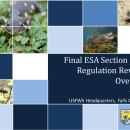States
Alabama, Alaska, American Samoa, Arizona, Arkansas, California, Colorado, Connecticut, Delaware, District of Columbia, Florida, Georgia, Guam, Hawaii, Idaho, Illinois, Indiana, Iowa, Kansas, Kentucky, Louisiana, Maine, Maryland, Massachusetts, Michigan, Minnesota, Mississippi, Missouri, Montana, Nebraska, Nevada, New Hampshire, New Jersey, New Mexico, New York, North Carolina, North Dakota, Northern Mariana Islands, Ohio, Oklahoma, Oregon, Pennsylvania, Puerto Rico, Rhode Island, South Carolina, South Dakota, Tennessee, Texas, Utah, Vermont, Virgin Islands, Virginia, Washington, West Virginia, Wisconsin, WyomingOn February 9, 2023, the U.S. Fish and Wildlife Service (Service) proposed a rule to improve the implementing regulations for and increase participation in the voluntary conservation programs associated with permitting take under ESA section 10(a)(1)(A) and section 10(a)(1)(B). The regulatory revisions respond to feedback the Service has received over the years from applicants, permittees, as well as Service managers and practitioners. A 60-day public comment period followed in which the Service received 71 public comments from stakeholders and interest groups. After reviewing the public comments received, the Service has now finalized the rule.
The final section 10(a) rule creates efficiencies and flexibility; simplifies processes; and clarifies concepts that are often sources of confusion and delays in the permitting process under section 10(a)(1)(A) and (B). The changes simplify section 10(a)(1)(A) by combining Candidate Conservation Agreements with Assurances and Safe Harbor Agreements into a new agreement type called a Conservation Benefit Agreement; ensure take is authorized under the appropriate conservation program; add flexibility to allow both Conservation Benefit Agreements and Habitat Conservation Plans to cover listed and non-listed species; and clarify the requirements for complete applications.
The improvements to the section 10(a) regulations, which will increase efficiency by reducing time and cost to develop and negotiate the required supporting documents, will encourage more individuals and companies to engage in Conservation Benefit Agreements and Habitat Conservation Plans, thereby generating greater conservation results overall. The final rule incorporates changes in response to public comments, but does not fundamentally change the revisions in the proposed rule.



